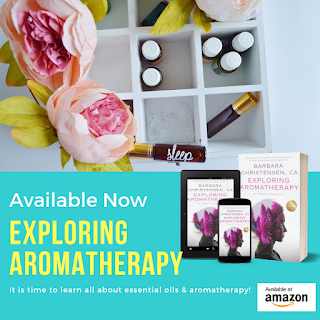Essential oil based perfumes are especially fun because they allow those of us who don't care for the strong aroma of synthetic perfumes to indulge in our own, signature scents. They offer a more subtle option for those who like to smell good but don't appreciate being overwhelmed by perfume from across the room. Indeed, if you're into essential oil perfumes, only those with whom you come into close contact will be able to share in your enjoyment of these special floral, herbal and spicy mixes. If you get headaches from regular perfumes, you might try out essential oil based blends to see if you're able to tolerate these any better.
Perfume is fun to mix, but it takes about a month to age a perfume blend that you concoct at home. Aging allows the scents to meld together and the alcohol to fade, so that the end result is a more blended mix, where, from a sensory perspective, you can't really tell where one flavor (note) of the perfume ends and the next begins.
If you'd like to experiment a bit with essential oil based perfumes at home, you may want to do a few different mixes all in one session, as you won't be able to put them to use for quite a while after you make them.
To make perfume from essential oils, you should probably have at least a small collection of a variety of oils - some base notes, some middle and some top (see list of examples, below.) Since it really doesn't take more than a few drops of oil to create a perfume, you can gather together some of your friends who have their own essential oil collections, and host a "perfume making party" where you can share a little of this and that to add variety and make it fun.
Each perfume blend should ideally contain a woodsy base which adds depth; a middle note; and a top note which is typically very pungent. Of course, you can make up your own recipes that do not follow this suggestion, but you'll probably find that they don't seem balanced without this harmonious, three-note "chord" of scents.
After you mix your perfume blend, you should add it to a dark colored bottle (you can start a collection of empty ones from essential oils that you purchase and eventually run out of). Store it in a cool, dark place for about 30 days and then shake well before using.
Common essential oil bases for perfumes include sandalwood, ginger, patchouli, vetiver, frankincense, cedarwood, and ylang ylang. For men I lean into the frankincense and cedarwood, although I love them both. The base note of your homemade perfume blend will contain the greatest amount of essential oil as compared to the middle and top notes. The top notes will consist of the smallest amount of essential oil.
Middle notes of essential oil perfumes carry through the mid-range, sort of like the melody in a song. Common middle-note scents are geranium, lavender, rose geranium, melissa, nutmeg, rosemary, balsam fir, roman chamomile, clove, clary sage, and a favorite... cardomom
Essential oil top notes take front and center in the order of which aromas hit your olfactory nerves in which order. They're sharper to the nose, and they require a smaller amount in comparison to base and middle notes of essential oil perfumes. Some examples: bergamot, tangerine, sweet basil, coriander seed, cinnamon, lemon, lime, orange, grapefruit, lemongrass, and peppermint.
Most importantly go with your instincts. Your intuition and how a smell feels to you may be the most important part of crafting your own essential oil blend. Have fun with it, and share if you create a winner. I know will want to try it ourselves.
Keep learning and growing!
Perfume is fun to mix, but it takes about a month to age a perfume blend that you concoct at home. Aging allows the scents to meld together and the alcohol to fade, so that the end result is a more blended mix, where, from a sensory perspective, you can't really tell where one flavor (note) of the perfume ends and the next begins.
If you'd like to experiment a bit with essential oil based perfumes at home, you may want to do a few different mixes all in one session, as you won't be able to put them to use for quite a while after you make them.
To make perfume from essential oils, you should probably have at least a small collection of a variety of oils - some base notes, some middle and some top (see list of examples, below.) Since it really doesn't take more than a few drops of oil to create a perfume, you can gather together some of your friends who have their own essential oil collections, and host a "perfume making party" where you can share a little of this and that to add variety and make it fun.
Each perfume blend should ideally contain a woodsy base which adds depth; a middle note; and a top note which is typically very pungent. Of course, you can make up your own recipes that do not follow this suggestion, but you'll probably find that they don't seem balanced without this harmonious, three-note "chord" of scents.
After you mix your perfume blend, you should add it to a dark colored bottle (you can start a collection of empty ones from essential oils that you purchase and eventually run out of). Store it in a cool, dark place for about 30 days and then shake well before using.
Common essential oil bases for perfumes include sandalwood, ginger, patchouli, vetiver, frankincense, cedarwood, and ylang ylang. For men I lean into the frankincense and cedarwood, although I love them both. The base note of your homemade perfume blend will contain the greatest amount of essential oil as compared to the middle and top notes. The top notes will consist of the smallest amount of essential oil.
Middle notes of essential oil perfumes carry through the mid-range, sort of like the melody in a song. Common middle-note scents are geranium, lavender, rose geranium, melissa, nutmeg, rosemary, balsam fir, roman chamomile, clove, clary sage, and a favorite... cardomom
Essential oil top notes take front and center in the order of which aromas hit your olfactory nerves in which order. They're sharper to the nose, and they require a smaller amount in comparison to base and middle notes of essential oil perfumes. Some examples: bergamot, tangerine, sweet basil, coriander seed, cinnamon, lemon, lime, orange, grapefruit, lemongrass, and peppermint.
Most importantly go with your instincts. Your intuition and how a smell feels to you may be the most important part of crafting your own essential oil blend. Have fun with it, and share if you create a winner. I know will want to try it ourselves.
Keep learning and growing!


















